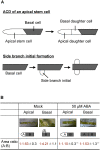Abscisic acid switches cell division modes of asymmetric cell division and symmetric cell division in stem cells of protonemal filaments in the moss Physcomitrium patens
- PMID: 35800966
- PMCID: PMC9200082
- DOI: 10.5511/plantbiotechnology.22.0107a
Abscisic acid switches cell division modes of asymmetric cell division and symmetric cell division in stem cells of protonemal filaments in the moss Physcomitrium patens
Abstract
Multicellular organisms regulate cell numbers and cell fate by using asymmetric cell division (ACD) and symmetric cell division (SCD) during their development and to adapt to unfavorable environmental conditions. A stem cell self-renews and generates differentiated cells. In plants, various types of cells are produced by ACD or SCD; however, the molecular mechanisms of ACD or SCD and the cell division mode switch are largely unknown. The moss Physcomitrium (Physcomitrella) patens is a suitable model to study plant stem cells due to its simple anatomy. Here, we report the cell division mode switch induced by abscisic acid (ABA) in P. patens. ABA is synthesized in response to abiotic stresses and induces round-shape cells, called brood cells, from cylindrical protonemal cells. Although two daughter cells with distinct sizes were produced by ACD in a protonemal stem cell on ABA-free media, the sizes of two daughter cells became similar with ABA treatment. Actin microfilaments were spatially localized on the apices of apical stem cells in protonemata on ABA-free media, but the polar accumulation was lost under the condition of ABA treatment. Moreover, ABA treatment conferred an identical cell fate to the daughter cells in terms of cell division activity. Collectively, the results indicate ABA may suppress the ACD characteristics but evoke SCD in cells. We also noticed that ABA-induced brood cells not only self-renewed but regenerated protonemal cells when ABA was removed from the media, suggesting that brood cells are novel stem cells that are induced by environmental signals in P. patens.
Keywords: Physcomitrium patens; abscisic acid (ABA); asymmetric cell division (ACD); stem cell; symmetric cell division (SCD).
© 2022 Japanese Society for Plant Biotechnology.
Figures




Similar articles
-
ABA signaling converts stem cell fate by substantiating a tradeoff between cell polarity, growth and cell cycle progression and abiotic stress responses in the moss Physcomitrium patens.Front Plant Sci. 2023 Nov 29;14:1303195. doi: 10.3389/fpls.2023.1303195. eCollection 2023. Front Plant Sci. 2023. PMID: 38093991 Free PMC article.
-
Spindle motility skews division site determination during asymmetric cell division in Physcomitrella.Nat Commun. 2022 May 5;13(1):2488. doi: 10.1038/s41467-022-30239-1. Nat Commun. 2022. PMID: 35513464 Free PMC article.
-
Sensor histidine kinases mediate ABA and osmostress signaling in the moss Physcomitrium patens.Curr Biol. 2022 Jan 10;32(1):164-175.e8. doi: 10.1016/j.cub.2021.10.068. Epub 2021 Nov 18. Curr Biol. 2022. PMID: 34798048
-
Physcomitrium patens: A Single Model to Study Oriented Cell Divisions in 1D to 3D Patterning.Int J Mol Sci. 2021 Mar 5;22(5):2626. doi: 10.3390/ijms22052626. Int J Mol Sci. 2021. PMID: 33807788 Free PMC article. Review.
-
Molecular mechanisms of reprogramming of differentiated cells into stem cells in the moss Physcomitrium patens.Curr Opin Plant Biol. 2022 Feb;65:102123. doi: 10.1016/j.pbi.2021.102123. Epub 2021 Nov 1. Curr Opin Plant Biol. 2022. PMID: 34735974 Review.
Cited by
-
Preface to the special issue "Stem cell reformation in plants".Plant Biotechnol (Tokyo). 2022 Mar 25;39(1):1-4. doi: 10.5511/plantbiotechnology.22.0000p. Plant Biotechnol (Tokyo). 2022. PMID: 35800967 Free PMC article. No abstract available.
-
Abscisic acid signaling regulates primary plasmodesmata density for plant cell-to-cell communication.Sci Adv. 2025 May 9;11(19):eadr8298. doi: 10.1126/sciadv.adr8298. Epub 2025 May 7. Sci Adv. 2025. PMID: 40333983 Free PMC article.
-
ABA signaling converts stem cell fate by substantiating a tradeoff between cell polarity, growth and cell cycle progression and abiotic stress responses in the moss Physcomitrium patens.Front Plant Sci. 2023 Nov 29;14:1303195. doi: 10.3389/fpls.2023.1303195. eCollection 2023. Front Plant Sci. 2023. PMID: 38093991 Free PMC article.
References
-
- Fisher AP, Sozzani R (2016) Uncovering the networks involved in stem cell maintenance and asymmetric cell division in the Arabidopsis root. Curr Opin Plant Biol 29: 38–43 - PubMed
-
- Glime JM, Bisang I (2017) Sexual strategies. Bryophyte Ecology 1: https://digitalcommons.mtu.edu/bryophyte-ecology1/2
-
- Goode JA, Stead AD, Duckett JG (1993) Redifferentiation of moss protonemata: An experimental and immunofluorescence study of brood cell formation. Can J Bot 71: 1510–1519
LinkOut - more resources
Full Text Sources
